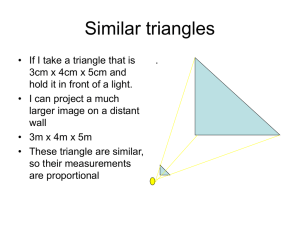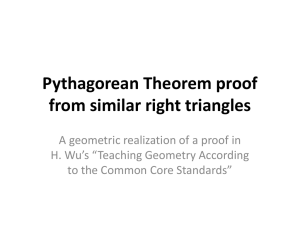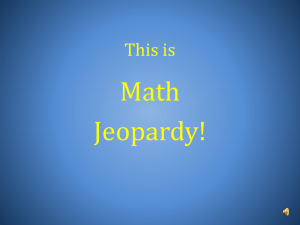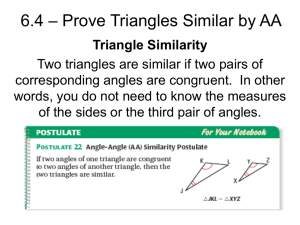2006-math-geometry
advertisement
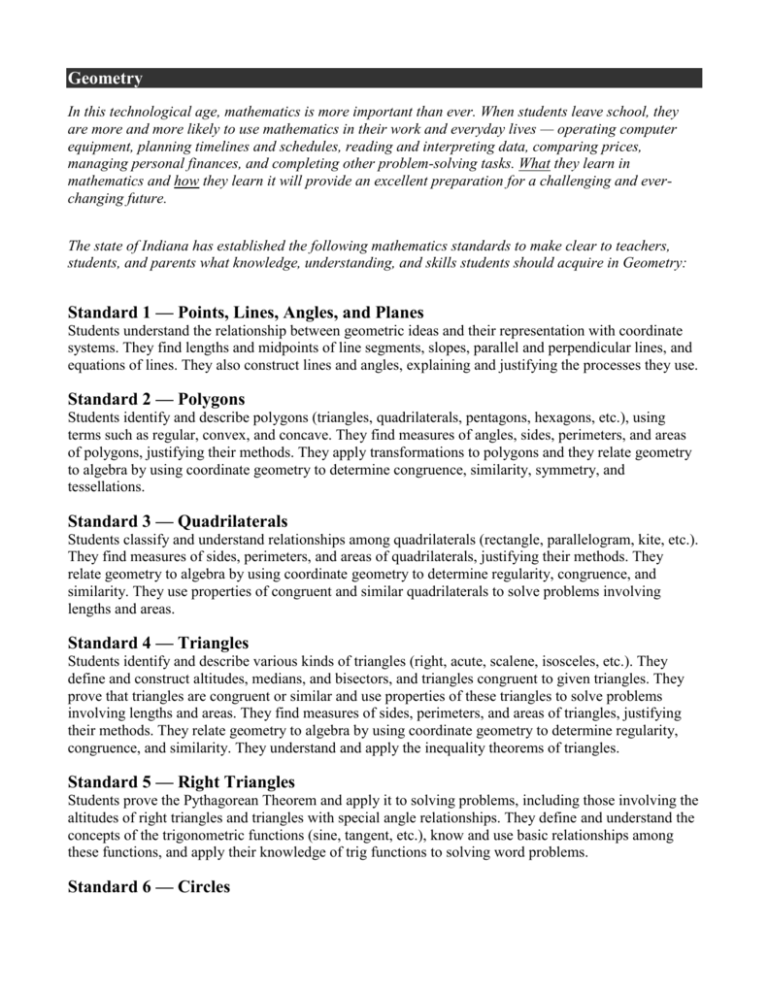
Geometry In this technological age, mathematics is more important than ever. When students leave school, they are more and more likely to use mathematics in their work and everyday lives — operating computer equipment, planning timelines and schedules, reading and interpreting data, comparing prices, managing personal finances, and completing other problem-solving tasks. What they learn in mathematics and how they learn it will provide an excellent preparation for a challenging and everchanging future. The state of Indiana has established the following mathematics standards to make clear to teachers, students, and parents what knowledge, understanding, and skills students should acquire in Geometry: Standard 1 — Points, Lines, Angles, and Planes Students understand the relationship between geometric ideas and their representation with coordinate systems. They find lengths and midpoints of line segments, slopes, parallel and perpendicular lines, and equations of lines. They also construct lines and angles, explaining and justifying the processes they use. Standard 2 — Polygons Students identify and describe polygons (triangles, quadrilaterals, pentagons, hexagons, etc.), using terms such as regular, convex, and concave. They find measures of angles, sides, perimeters, and areas of polygons, justifying their methods. They apply transformations to polygons and they relate geometry to algebra by using coordinate geometry to determine congruence, similarity, symmetry, and tessellations. Standard 3 — Quadrilaterals Students classify and understand relationships among quadrilaterals (rectangle, parallelogram, kite, etc.). They find measures of sides, perimeters, and areas of quadrilaterals, justifying their methods. They relate geometry to algebra by using coordinate geometry to determine regularity, congruence, and similarity. They use properties of congruent and similar quadrilaterals to solve problems involving lengths and areas. Standard 4 — Triangles Students identify and describe various kinds of triangles (right, acute, scalene, isosceles, etc.). They define and construct altitudes, medians, and bisectors, and triangles congruent to given triangles. They prove that triangles are congruent or similar and use properties of these triangles to solve problems involving lengths and areas. They find measures of sides, perimeters, and areas of triangles, justifying their methods. They relate geometry to algebra by using coordinate geometry to determine regularity, congruence, and similarity. They understand and apply the inequality theorems of triangles. Standard 5 — Right Triangles Students prove the Pythagorean Theorem and apply it to solving problems, including those involving the altitudes of right triangles and triangles with special angle relationships. They define and understand the concepts of the trigonometric functions (sine, tangent, etc.), know and use basic relationships among these functions, and apply their knowledge of trig functions to solving word problems. Standard 6 — Circles Students define and understand ideas related to circles (radius, tangent, chord, etc.). They perform constructions and prove theorems related to circles. They find measures of arcs and angles related to them, as well as measures of circumference and area, and they relate geometry to algebra by finding the equation of a circle in the coordinate plane. Standard 7 — Polyhedra and Other Solids Students describe and make regular and nonregular polyhedra (cube, pyramid, tetrahedron, octahedron, etc.). They explore relationships among the faces, edges, and vertices of polyhedra. They describe sets of points on spheres, using terms such as great circle. They describe symmetries of solids and understand the properties of congruent and similar solids. Standard 8 — Mathematical Reasoning and Problem Solving In a general sense, mathematics is problem solving. In all mathematics, students use problem-solving skills: they choose how to approach a problem, they explain their reasoning, and they check their results. At this level, students apply these skills to making conjectures, using axioms and theorems, understanding the converse and contrapositive of a statement, constructing logical arguments, and writing geometric proofs. They also learn about inductive and deductive reasoning and how to use counterexamples to show that a general statement is false. As part of their instruction and assessment, students should also develop the following learning skills by Grade 12 that are woven throughout the mathematics standards: Communication The ability to read, write, listen, ask questions, think, and communicate about math will develop and deepen students’ understanding of mathematical concepts. Students should read text, data, tables, and graphs with comprehension and understanding. Their writing should be detailed and coherent, and they should use correct mathematical vocabulary. Students should write to explain answers, justify mathematical reasoning, and describe problem-solving strategies. Representation The language of mathematics is expressed in words, symbols, formulas, equations, graphs, and data displays. The concept of one-fourth may be described as a quarter, 1 4 , one divided by four, 0.25, 1 + 1 , 25 percent, or an appropriately shaded portion of a pie graph. Higher-level mathematics 8 8 involves the use of more powerful representations: exponents, logarithms, π, unknowns, statistical representation, algebraic and geometric expressions. Mathematical operations are expressed as representations: +, =, divide, square. Representations are dynamic tools for solving problems and communicating and expressing mathematical ideas and concepts. Connections Connecting mathematical concepts includes linking new ideas to related ideas learned previously, helping students to see mathematics as a unified body of knowledge whose concepts build upon each other. Major emphasis should be given to ideas and concepts across mathematical content areas that help students see that mathematics is a web of closely connected ideas (algebra, geometry, the entire number system). Mathematics is also the common language of many other disciplines (science, technology, finance, social science, geography) and students should learn mathematical concepts used in those disciplines. Finally, students should connect their mathematical learning to appropriate real-world contexts. Standard 1 Points, Lines, Angles, and Planes Students find lengths and midpoints of line segments. They describe and use parallel and perpendicular lines. They find slopes and equations of lines. G.1.1 Find the lengths and midpoints of line segments in one- or two-dimensional coordinate systems. Example: Find the length and midpoint of the line joining the points A (3, 8) and B (9, 0). G.1.2 Construct congruent segments and angles, angle bisectors, and parallel and perpendicular lines using a straight edge and compass, explaining and justifying the process used. Example: Construct the perpendicular bisector of a given line segment, justifying each step of the process. G.1.3 Understand and use the relationships between special pairs of angles formed by parallel lines and transversals. Example: In the diagram, the lines k and l are parallel. What is the measure of angle x? Explain your answer. 113 x G.1.4 k l Use coordinate geometry to find slopes, parallel lines, perpendicular lines, and equations of lines. Example: Find an equation of a line perpendicular to y = 4x – 2. Standard 2 Polygons Students identify and describe polygons and measure interior and exterior angles. They use congruence, similarity, symmetry, tessellations, and transformations. They find measures of sides, perimeters, and areas. G.2.1 Identify and describe convex, concave, and regular polygons. Example: Draw a regular hexagon. Is it convex or concave? Explain your answer. G.2.2 Find measures of interior and exterior angles of polygons, justifying the method used. Example: Calculate the measure of one interior angle of a regular octagon. Explain your method. G.2.3 Use properties of congruent and similar polygons to solve problems. Example: Divide a regular hexagon into triangles by joining the center to each vertex. Show that these triangles are all the same size and shape and find the sizes of the interior angles of the hexagon. G.2.4 Apply transformations (slides, flips, turns, expansions, and contractions) to polygons to determine congruence, similarity, symmetry, and tessellations. Know that images formed by slides, flips, and turns are congruent to the original shape. Example: Use a drawing program to create regular hexagons, regular octagons, and regular pentagons. Under the drawings, describe which of the polygons would be best for tiling a rectangular floor. Explain your reasoning. G.2.5 Find and use measures of sides, perimeters, and areas of polygons. Relate these measures to each other using formulas. Example: A rectangle of area 360 square yards is ten times as long as it is wide. Find its length and width. G.2.6 Use coordinate geometry to prove properties of polygons such as regularity, congruence, and similarity. Example: Is the polygon formed by connecting the points (2, 1), (6, 2), (5, 6), and (1, 5) a square? Standard 3 Quadrilaterals Students identify and describe simple quadrilaterals. They use congruence and similarity. They find measures of sides, perimeters, and areas. G.3.1 Describe, classify, and understand relationships among the quadrilaterals square, rectangle, rhombus, parallelogram, trapezoid, and kite. Example: Use a drawing program to create a square, rectangle, rhombus, parallelogram, trapezoid, and kite. Judge which of the quadrilaterals has perpendicular diagonals and draw those diagonals in the figures. Give a convincing argument that your judgment is correct. G.3.2 Use properties of congruent and similar quadrilaterals to solve problems involving lengths and areas. Example: Of two similar rectangles, the second has sides three times the length of the first. How many times larger in area is the second rectangle? G.3.3 Find and use measures of sides, perimeters, and areas of quadrilaterals. Relate these measures to each other using formulas. Example: A section of roof is a trapezoid with length 4 m at the ridge and 6 m at the gutter. The shortest distance from ridge to gutter is 3 m. Construct a model using a drawing program, showing how to find the area of this section of roof. G.3.4 Use coordinate geometry to prove properties of quadrilaterals, such as regularity, congruence, and similarity. Example: Is rectangle ABCD with vertices at (0, 0), (4, 0), (4, 2), (0, 2) congruent to rectangle PQRS with vertices at (-2, -1), (2, -1), (2, 1), (-2, 1)? Standard 4 Triangles Students identify and describe types of triangles. They identify and draw altitudes, medians, and angle bisectors. They use congruence and similarity. They find measures of sides, perimeters, and areas. They apply inequality theorems. G.4.1 Identify and describe triangles that are right, acute, obtuse, scalene, isosceles, equilateral, and equiangular. Example: Use a drawing program to create examples of right, acute, obtuse, scalene, isosceles, equilateral, and equiangular triangles. Identify and describe the attributes of each triangle. G.4.2 Define, identify, and construct altitudes, medians, angle bisectors, and perpendicular bisectors. Example: Draw several triangles. Construct their angle bisectors. What do you notice? G.4.3 Construct triangles congruent to given triangles. Example: Construct a triangle given the lengths of two sides and the measure of the angle between the two sides. G.4.4 Use properties of congruent and similar triangles to solve problems involving lengths and areas. Example: Of two similar triangles, the second has sides half the length of the first. The area of the first triangle is 20 cm2. What is the area of the second? G.4.5 Prove and apply theorems involving segments divided proportionally. Example: In triangle ABC, PQ is parallel to BC . What is the length of AQ ? A 4 P 12 B Q 18 C G.4.6 Prove that triangles are congruent or similar and use the concept of corresponding parts of congruent triangles. Example: In the last example, prove that triangles ABC and APQ are similar. G.4.7 Find and use measures of sides, perimeters, and areas of triangles. Relate these measures to each other using formulas. Example: The gable end of a house is a triangle 20 feet long and 13 feet high. Find its area. G.4.8 Prove, understand, and apply the inequality theorems: triangle inequality, inequality in one triangle, and the hinge theorem. Example: Can you draw a triangle with sides of length 7 cm, 4 cm, and 15 cm? G.4.9 Use coordinate geometry to prove properties of triangles such as regularity, congruence, and similarity. Example: Draw a triangle with vertices at (1, 3), (2, 5), and (6, 1). Draw another triangle with vertices at (-3, -1), (-2, 1), and (2, -3). Are these triangles the same shape and size? Standard 5 Right Triangles Students prove the Pythagorean Theorem and use it to solve problems. They define and apply the trigonometric relations sine, cosine, and tangent. G.5.1 Prove and use the Pythagorean Theorem. Example: On each side of a right triangle, draw a square with that side of the triangle as one side of the square. Find the areas of the three squares. What relationship is there between the areas? G.5.2 State and apply the relationships that exist when the altitude is drawn to the hypotenuse of a right triangle. Example: In triangle ABC with right angle at C, draw the altitude CD from C to AB . Name all similar triangles in the diagram. Use these similar triangles to prove the Pythagorean Theorem. G.5.3 Use special right triangles (30° - 60° and 45° - 45°) to solve problems. Example: An isosceles right triangle has one short side of 6 cm. Find the lengths of the other two sides. G.5.4 Define and use the trigonometric functions (sine, cosine, tangent, cotangent, secant, cosecant) in terms of angles of right triangles. Example: In triangle ABC, tan A = 1 5 . Find sin A and cot A. G.5.5 Know and use the relationship sin2 x + cos2 x = 1. Example: Show that, in a right triangle, sin2 x + cos2 x = 1 is an example of the Pythagorean Theorem. G.5.6 Solve word problems involving right triangles. Example: The force of gravity pulling an object down a hill is its weight multiplied by the sine of the angle of elevation of the hill. What is the force on a 3,000-pound car on a hill with a 1 in 5 grade? (A grade of 1 in 5 means that the hill rises one unit for every five horizontal units.) Standard 6 Circles Students define ideas related to circles: e.g., radius, tangent. They find measures of angles, lengths, and areas. They prove theorems about circles. They find equations of circles. G.6.1 Find the center of a given circle. Construct the circle that passes through three given points not on a line. Example: Given a circle, find its center by drawing the perpendicular bisectors of two chords. G.6.2 Define and identify relationships among: radius, diameter, arc, measure of an arc, chord, secant, and tangent. Example: What is the angle between a tangent to a circle and the radius at the point where the tangent meets the circle? G.6.3 Prove theorems related to circles. Example: Prove that an inscribed angle in a circle is half the measure of the central angle with the same arc. G.6.4 Construct tangents to circles and circumscribe and inscribe circles. Example: Draw an acute triangle and construct the circumscribed circle. G.6.5 Define, find, and use measures of arcs and related angles (central, inscribed, and intersections of secants and tangents). Example: Find the measure of angle ABC in the diagram below. A B 150 9 9 99 C G.6.6 Define and identify congruent and concentric circles. Example: Are circles with the same center always the same shape? Are they always the same size? G.6.7 Define, find, and use measures of circumference, arc length, and areas of circles and sectors. Use these measures to solve problems. Example: Which will give you more: three 6-inch pizzas or two 8-inch pizzas? Explain your answer. G.6.8 Find the equation of a circle in the coordinate plane in terms of its center and radius. Example: Find the equation of the circle with radius 10 and center (6, -3). Standard 7 Polyhedra and Other Solids Students describe and make polyhedra and other solids. They describe relationships and symmetries, and use congruence and similarity. G.7.1 Describe and make regular and nonregular polyhedra. Example: Is a cube a regular polyhedron? Explain why or why not. G.7.2 Describe the polyhedron that can be made from a given net (or pattern). Describe the net for a given polyhedron. Example: Make a net for a tetrahedron out of poster board and fold it up to make the tetrahedron. G.7.3 Describe relationships between the faces, edges, and vertices of polyhedra. Example: Count the sides, edges, and corners of a square-based pyramid. How are these numbers related? G.7.4 Describe symmetries of geometric solids. Example: Describe the rotation and reflection symmetries of a square-based pyramid. G.7.5 Describe sets of points on spheres: chords, tangents, and great circles. Example: On Earth, is the equator a great circle? G.7.6 Identify and know properties of congruent and similar solids. Example: Explain how the surface area and volume of similar cylinders are related. G.7.7 Find and use measures of sides, volumes of solids, and surface areas of solids. Relate these measures to each other using formulas. Example: An ice cube is dropped into a glass that is roughly a right cylinder with a 6 cm diameter. The water level rises 1 mm. What is the volume of the ice cube? Standard 8 Mathematical Reasoning and Problem Solving Students use a variety of strategies to solve problems. G.8.1 Use a variety of problem-solving strategies, such as drawing a diagram, making a chart, guess-and-check, solving a simpler problem, writing an equation, and working backwards. Example: How far does the tip of the minute hand of a clock move in 20 minutes if the tip is 4 inches from the center of the clock? G.8.2 Decide whether a solution is reasonable in the context of the original situation. Example: John says the answer to the problem in the first example is 12 inches. Is his answer reasonable? Why or why not? Students develop and evaluate mathematical arguments and proofs. G.8.3 Make conjectures about geometric ideas. Distinguish between information that supports a conjecture and the proof of a conjecture. Example: Calculate the ratios of side lengths in several different-sized triangles with angles of 90°, 50°, and 40°. What do you notice about the ratios? How might you prove that your observation is true (or show that it is false)? G.8.4 Write and interpret statements of the form “if – then” and “if and only if.” Example: Decide whether this statement is true: “If today is Sunday, then we have school tomorrow.” G.8.5 State, use, and examine the validity of the converse, inverse, and contrapositive of “if – then” statements. Example: In the last example, write the converse of the statement. G.8.6 Identify and give examples of undefined terms, axioms, and theorems, and inductive and deductive proofs. Example: Do you prove axioms from theorems or theorems from axioms? G.8.7 Construct logical arguments, judge their validity, and give counterexamples to disprove statements. Example: Find an example to show that triangles with two sides and one angle equal are not necessarily congruent. G.8.8 Write geometric proofs, including proofs by contradiction and proofs involving coordinate geometry. Use and compare a variety of ways to present deductive proofs, such as flow charts, paragraphs, and two-column and indirect proofs. Example: In triangle LMN, LM = LN. Prove that LMN LNM. G.8.9 Perform basic constructions, describing and justifying the procedures used. Distinguish between constructing and drawing geometric figures. Example: Construct a line parallel to a given line through a given point not on the line, explaining and justifying each step.




